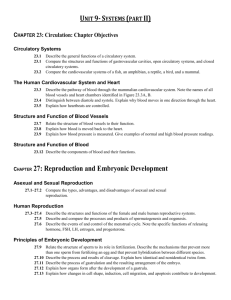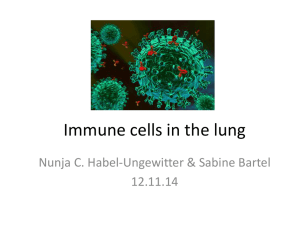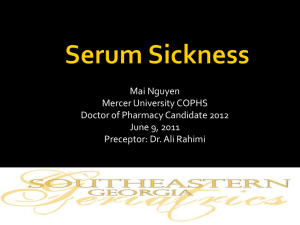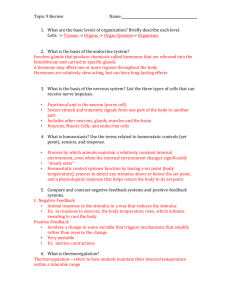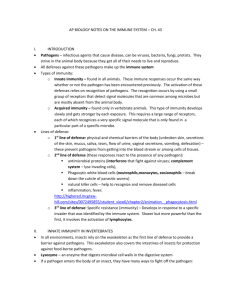vertebrates peptides
advertisement
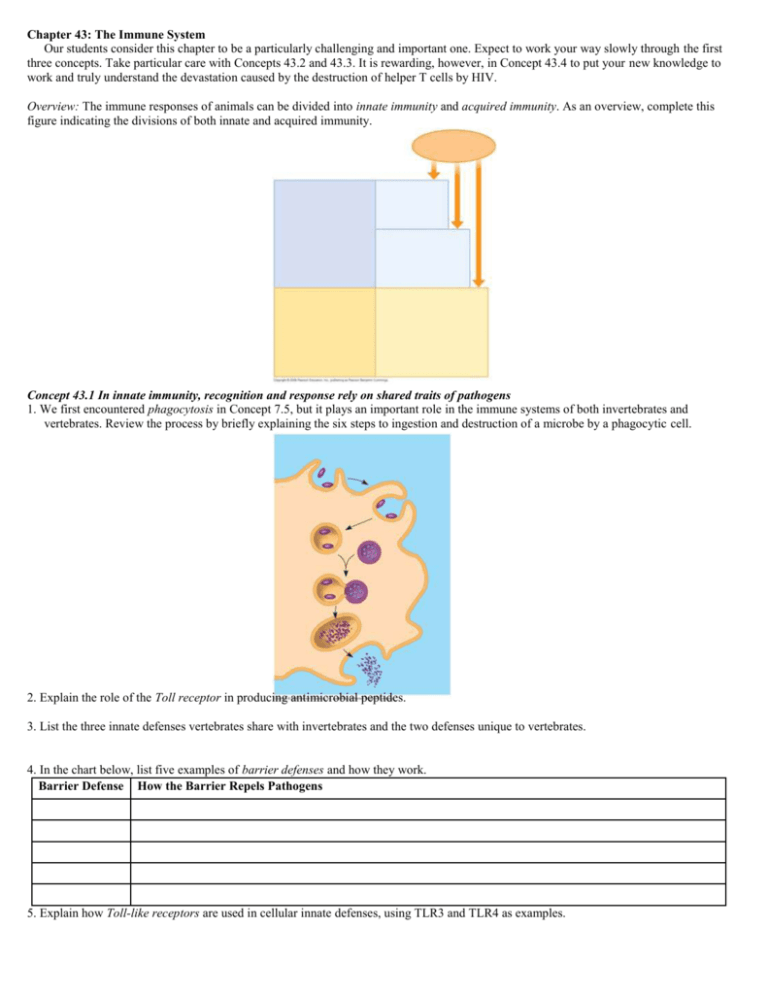
Chapter 43: The Immune System Our students consider this chapter to be a particularly challenging and important one. Expect to work your way slowly through the first three concepts. Take particular care with Concepts 43.2 and 43.3. It is rewarding, however, in Concept 43.4 to put your new knowledge to work and truly understand the devastation caused by the destruction of helper T cells by HIV. Overview: The immune responses of animals can be divided into innate immunity and acquired immunity. As an overview, complete this figure indicating the divisions of both innate and acquired immunity. Concept 43.1 In innate immunity, recognition and response rely on shared traits of pathogens 1. We first encountered phagocytosis in Concept 7.5, but it plays an important role in the immune systems of both invertebrates and vertebrates. Review the process by briefly explaining the six steps to ingestion and destruction of a microbe by a phagocytic cell. 2. Explain the role of the Toll receptor in producing antimicrobial peptides. 3. List the three innate defenses vertebrates share with invertebrates and the two defenses unique to vertebrates. 4. In the chart below, list five examples of barrier defenses and how they work. Barrier Defense How the Barrier Repels Pathogens 5. Explain how Toll-like receptors are used in cellular innate defenses, using TLR3 and TLR4 as examples. 6. In the chart below, explain the role of the four phagocytic cells. Phagocytic Cell Type Role in Innate Defense Neutrophils Macrophages Eosinophils Dendritic cells 7. In the figure below, trace the flow of lymph in four stages. For each stage, explain the role of the lymphatic system in innate defense. 8. Explain the role of the following two antimicrobial compounds. Interferon Complement 9. Use the figure below to explain the three steps of an inflammatory response. 10. What role do natural killer cells play in the immune system? 11. It might seem like pathogens have little hope of mounting an infection, but do not forget that pathogens are constantly evolving ways to circumvent our immune system. As examples, how do the pathogens that cause pneumonia and tuberculosis avoid our immune responses? Concept 43.2 In acquired immunity, lymphocyte receptors provide pathogen-specific recognition 12. From the first four paragraphs of this concept, summarize where T cells and B cells develop, and give an overview of their functions. (Note that they are a type of white blood cell known as a lymphocyte.) 13. What is immunological memory, and why is it important? 14. Explain how cytokines help coordinate the innate and acquired immune responses. 15. The following brief questions will serve as a primer for immune system recognition. a. What is an antigen? b. What is the relationship between an antigen receptor, an antibody, and an immunoglobin? c. How is an epitope related to an antigen? (Look at Figure 43.10.) 16. In the figure of a B cell below, label the antigen-binding sites, light and heavy chains, variable and constant regions, transmembrane region, and disulfide bridges. 17. What forms the specific antigen-binding site? (Be sure to note that each B cell produces only one type of antigen receptor. For any one cell, all antigen receptors or antibodies produced are identical.) 18. In the figure of a T cell below, label the antigen-binding site, alpha and beta chain, variable and constant regions, transmembrane region, and disulfide bridge. 19. T cells also display only one type of antigen receptor on the surface of the cell. Compare and contrast a T cell with a B cell. 20. B-cell receptors recognize and bind to antigens whether they are free antigens (like a secreted toxin) or on the surface of a pathogen. Explain the role of the major histocompatibility complex (MHC) to T-cell receptor binding. 21. Explain how an infected host cell uses the MHC molecule to display an antigen. 22. Explain the differences between Class I and Class II MHC molecules, noting type of cells that display the molecule, types of diseases involved with each molecule, and what type of T cell recognizes the MHC molecules. Diseases associated with (cancer, MHC Class Displayed by? Recognized by which T cells? viral or bacterial)? Class I MHC Class II MHC 23. Using Figure 43.12 as a guide, label completely the figure below. 24. List three properties of the acquired immune system. 25. One of the early problems in immunology was trying to understand how an organism with a limited number of genes (for humans, about 20,500) could produce a million different B-cell protein receptors and 10 million different T-cell protein receptors! The answer resulted in a Nobel Prize and a startling exception to the notion that all cells have exactly the same DNA. Use the figure below to label and explain the four steps involved in producing genetically unique B-cell receptors. 26. Explain how the body develops self-tolerance in the immune system. 27. Define the following terms. Effector cells Memory cells Clonal selection 28. Using the blue text in the margin of Figure 43.14, explain the four key events to clonal selection. 29. Graphs similar to the one below have been seen on several AP Biology exams. It depicts the primary and secondary immune response. The first arrow shows exposure to antigen A. The second arrow shows exposure to antigen A again, and also antigen B. Label this graph and then use it to explain the difference between a primary and secondary immune response. Concept 43.3 Acquired immunity defends against infection of body cells and fluids 30. Explain fully the function of the two divisions of acquired immunity. Humoral immune response Cell-mediated immune response 31. Helper T cells play a critical role in activation of both T cells and B cells. In full detail, label and explain the three steps involved using Figure 43.17. This is an important step! 32. Explain the role of dendritic cells and macrophages in starting a primary and secondary immune response. 33. _________________________________________ are the effector cells in cell-mediated immunity. 34. What must occur for a cytotoxic T cell to become activated? 35. Completely label the diagram below. Then carefully explain the three primary steps that occur as a cytotoxic T cell destroys a target cell. 36. How is B-cell antigen presentation unique? 37. Completely label the diagram below. Then carefully explain the three primary steps that occur in B cell activation. 38. What is the difference between plasma cells and memory cells produced from the activation of B cells? 39. Explain how monoclonal antibodies are used in home pregnancy kits. 40. Why is the antibody response to a microbial infection polyclonal? 41. Explain these three ways antibodies can dispose of antigens. Viral neutralization Opsonization Activation of complement 42. Using examples, explain the difference between active and passive immunity. 43. Describe how immunizations can serve as an example of active immunity. 44. Why is immune rejection an example of a healthy immune system? 45. Briefly describe the following features of immune rejection. a. Explain how antibodies against blood types are present. b. What is the role of MHC in tissue and organ transplants? c. Why are bone marrow transplants medically unique? Concept 43.4 Disruptions in immune system function can elicit or exacerbate disease 46. What are allergies? 47. Label Figure 43.23 and then use it to explain a typical allergic response. 48. Explain what happens if a person experiences anaphylactic shock. 49. Autoimmune diseases occur when the immune system turns against particular molecules of the body. Describe the cause and symptoms of the following autoimmune diseases. Lupus Rheumatoid arthritis Type 1 diabetes mellitus Multiple sclerosis 50. Explain how immunodeficiency diseases are different from autoimmune diseases. 51. Just as our immune system has evolved to thwart pathogens, pathogens have evolved to thwart our immune system. Describe the following pathogen strategies. Antigenic variation Latency Attack on the immune system: HIV 52. Explain how the high mutation rate in surface antigen genes in HIV has hampered development of a vaccine for AIDS. (You might take note that HIV—human immunodeficiency virus—is the virus that causes the disease AIDS—acquired immunodeficiency syndrome. These acronyms are often used incorrectly.)


